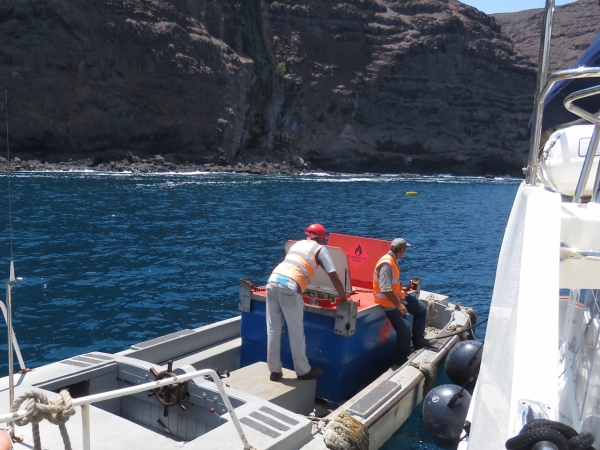
When you travel the world, the boat sometimes has to be docked in less than optimum conditions. Nobody wants to med moor against a concrete wall in a large swell and without protection. But, if you want fuel in Nuku Hiva, you’ll need to be able to safely dock in these conditions. Nobody wants to raft up against a commercial barge in a 3-ft ocean swell. But, if you want fuel in St. Helena, you’ll need to have enough fenders to keep distance between your boat and the barge, even when an ocean swell is running. Docking in Rodrigues isn’t bad, but it is up against an abrasive concrete wall. In Reunion and Barbados, a constant swell runs through the marinas. Many times we end up using fixed commercial docks because that’s all that is available. After eight years of cruising the world, we have never taken boat damage in these situations. The secret is to have a lot of very large fenders.
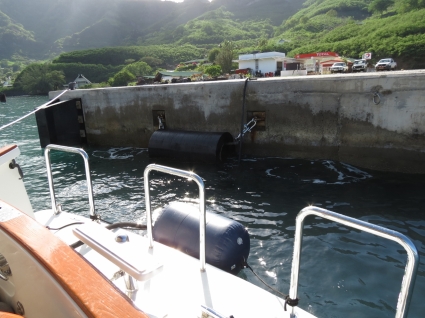
|
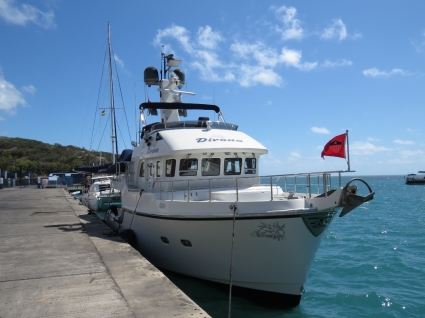
|
It’s simple enough to deploy many very large fenders when at the dock. What’s difficult is finding a place to stow all those fenders on a small boat. The obvious solution is to use inflatable fenders. Inflatables allow large fenders to be available for ample protection. More protection means, if conditions get worse or a fender slips, you don’t risk boat damage. The advantage of inflatables is they stow in a remarkably small space.
We often look to super yachts for solutions since they travel a lot, face the same conditions we do, and most have experienced crews that know how to avoid damage. Super yachts frequently use inflatable fenders to get the advantage of being able to use over-sized fenders without giving up large amounts of deck space or simply being ugly when under way. Back in 2010, Aere was the inflatable fender of choice so we bought a set to replace our existing fenders.
Over time we learned what worked best with our boat and eventually spent $2,850 on Aere inflatable fenders. We standardized on 3 18×42-inch fenders down each side with a larger 24×42-inch fender at the front where the bow starts to taper. It worked super well and we had enough on board to do both sides.
The only downside of such big fenders is that sometimes there isn’t an additional 36 inches of space left between us and the dock to allow space for them. For those situations, we also have 4 12×72-in fenders that we deploy with 2 on each side of the boat. We only use these in calm conditions, where space is limited, but they are a nice solution for those conditions. The “sausages” as we call them also are useful when transiting a crowded lock, such as the Lake Washington Ship Canal, where other craft of varying sizes might be rafted against us.
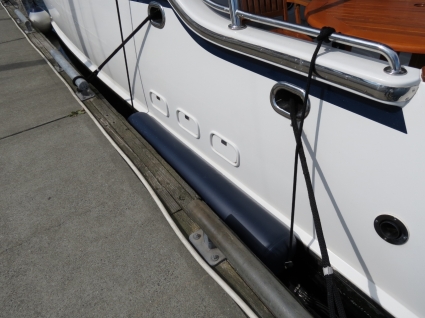
The Aere fenders are beasts and, across many dimensions, performed well. They used a very thick fabric that could rub against a concrete wall for months without a problem. They are incredibly strong and we never worried about them in tropical storm force winds. But, and this is a big but, the seams leaked. Some of them leaked on day one and, after a year, they all leaked.
Aere was great to work with and were happy to repair the fenders under warranty or send us repair material. The cost of return transport halfway across the world for a large inflatable fender exceeds the cost of the fender, so we decided to invest the time to repair the leaks ourselves. The fenders were amazing in every other dimension, so it seemed sensible to just fix them. We fix leaks in the tender when needed and the fixes last well, so we were optimistic, willing to spend the time, and appreciate that Aere sent us lots of material for repairs.
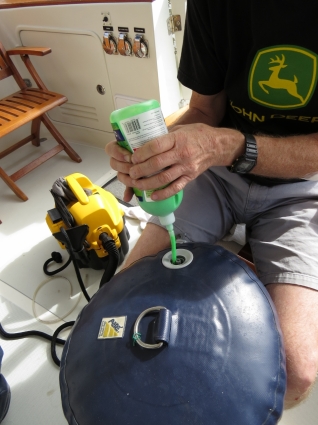
What we learned and, in retrospect, learned far slower than we should have learned, was the leaks were never going to be fixed. The seams leaked everywhere and the time we spent in repairs was starting to feel like a real waste. We loved the fenders in all other ways, but needed a better solution. Around this time, we started to notice super yachts deploying ProStock Marine fenders. And a couple of times we saw entire sets of Aere fenders, in apparently good shape, in the marina garbage.
We weren’t happy to effectively give up on a $2,850 investment after only two years but there are times when the best favor you can do yourself is admit when you were wrong and try something else. The combination of seeing the ProStock Marine fenders showing up on more and more super yachts and them having a 5-year warranty pushed us in that direction. It was another $2,350 but this time it’s $2,350 spread over at least the 5-year warranty period, and hopefully more. Typically you expect average life to be longer than the warranty period, so this would be at most $470/year in fenders, much better than the $1,425/year we got with the Aere fenders.
When the ProStocks arrived we worried a bit about the thinness of the material but, over time, we were impressed. The seams don’t leak and the material, although much thinner than the Aere, still seemed to take a beating and keep operating.
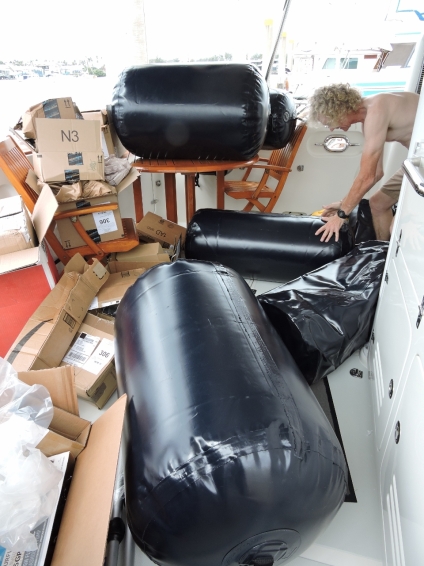
|
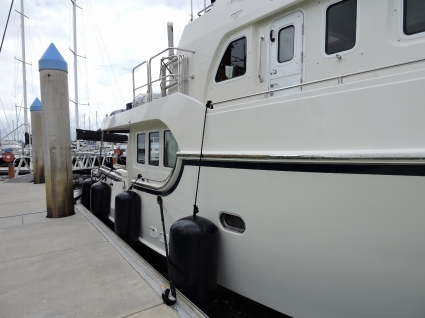
|
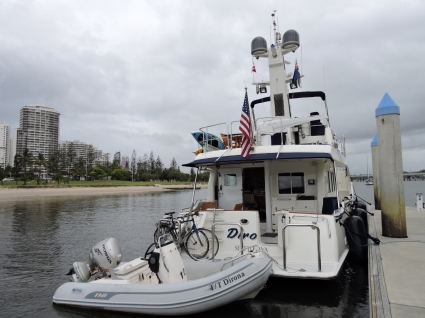
|
After three years we felt pretty good about the move to ProStock Marine and then four events happened within a month that have sent us back to the drawing board:
- During a moderate December storm in Dublin, with winds in the low 30-kts and temperatures in the mid 30s F, the two fenders closest to the center of the boat both failed in the same evening. This was a huge concern since it’s a multiple fender failure and these two central fenders are our primary protection. In this case, we were saved only by the fact that we use very large fenders and lots of them. Other fenders took the load when we lost these two. However, this caused us to wonder if our 100% dependence on inflatables was the right choice.
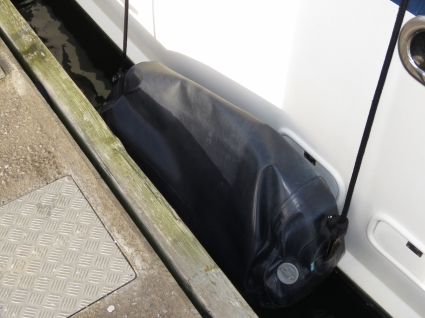
- Two weeks later in Falmouth, during a major storm that sent gusts to 56 kts and a multiple-foot wind waves rolling through the marina, the 130-ft super yacht in front of us had all of their inflatable fenders blown up on dock. With winds over 50 kts and large wind-driven waves, that boat would have taken severe damage except for an usually attentive staff at Port Pendennis Marina. In the middle of the night, they arrived and inspected all boats and put new fenders down where there was potential trouble. They saved the 130’ sailboat using Polyform F-8 fenders.
- This was super interesting for us in that the Polyforms were large for a fixed fender, but still much smaller than the super-sized inflatable fenders the boat was using. The next morning the winds were still in the 30-40-kt range and the high weight-to-size ration of the Polyform held them rock solid between the boat and the dock. We liked the performance of the Polyforms and, man, they are thick and heavy. Seeing all of a boat’s inflatables fenders blown up on the dock was unnerving. Most marinas don’t send out crews at 1am to save boats and, had Port Pendennis not done this, that boat would have been completely unprotected in more than 50-kt winds.
- In the picture below from shortly past midnight, the superyacht’s stern fender is visible on the dock, circled in red, with the Port Pendennis marina staff arriving on the right wearing headlamps. And the left side of the picture shows the size of the waves moving through the marina (click image for a larger view).
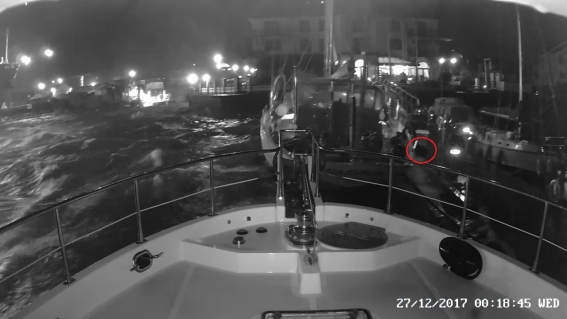
- In the same evening during the same storm in Falmouth, with the 56 kts winds and multi-foot wind waves rolling through the anchorage, our aft (windward) inflatable fender was up on dock. We were saved by the size and number of fenders we had deployed, but it’s not nice to see a fender resting on the dock after an evening of more than 50kts.
- In Portland, a week after the Falmouth storm, we woke to steady winds in the 50-kt range and overnight had seen gusts as high as 72kts. The waves were so big they were rolling across the double-width dock and hitting our boat. The dock power pedestals were basically underwater and the entire dock was without power. Conditions were, by a large margin, the worst we had ever seen.Two of our fenders had blown up onto our walkway and a third was held above the dock by the force of the wind. We basically had no fender coverage for the front half of the boat. This was the same problem that the super yacht had at Falmouth except nobody had come out to add new fenders. The only thing that had saved the boat was that the wind was blowing us off the dock rather than on to it. Winds from a different direction would likely have left us with thousands of dollars in damage. It’s really unnerving to see conditions that bad and have no fender protection. This convinced us we needed a different approach.
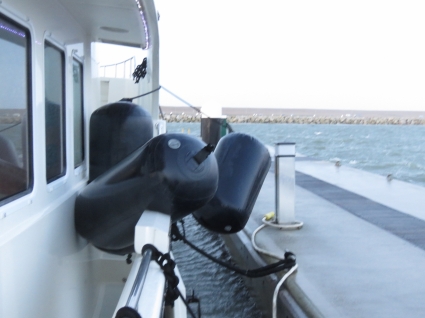
When we reported the multiple fender failure to ProStock Marine, they said “please send us pictures, we’ll take care of you.” We sent pictures and ProStock got back to us saying “we were operating in extreme conditions and the fenders are not sufficiently large for our boat”. They did offer to replace the fenders at 10% off the retail price. But any retailer will give us more than 10% off of retail price when making a multiple fender purchase, so the 10% reduction from retail price ProStock Marina offered would actually have been more expensive than our just purchasing fenders through the retail channel. We pointed out that something closer to their cost would be more reasonable than 10% off of retail for fenders that had failed only three years into a five-year warranty period. That was the last we heard from ProStock Marine. They appear to have no warranty at all.
ProStock Marine never did get back to us, but another boat owner who was considering new fenders asked them why we didn’t get warranty. ProStock replied “if we sent them in and there was a manufacturing problem, they would repair or replace them.” Shipping costs would be our responsibility though. Since it costs more to ship the fenders both ways from Europe than it does to get new fenders, that didn’t sound like much of a solution. And, having been told “we were operating in extreme conditions and the fenders are not sufficiently large for our boat” it seemed highly unlikely that they would “find” a manufacturing problem.
A third ProStock Marine fender is showing the same deteriorating PVC fabric problem and likely will fail soon. It appears that PVC fenders as they age become sensitive to even near-freezing temperatures and, if the fabric is worked, they will fail. It also appears that if the valve is between the boat and the dock, the fabric is worked harder than if the valve is 90 degrees to the boat and dock. The valve forms a non-flexible section and the fabric works harder on both sides of it. The combination of cooler temperatures and the placement of the valve appears to cause failure. The valve placement would be an easy problem to solve in manufacture and many of our fenders don’t have that valve orientation. The aging of the PVC fabric and its susceptibility to cold weather failures would be harder to fix.
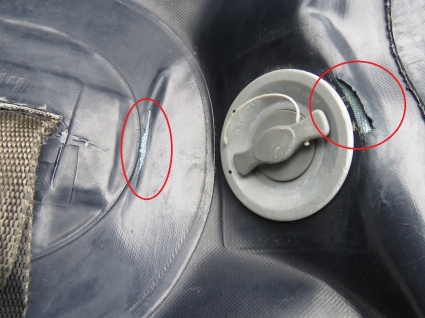
Arguably we’re getting closer to a reasonable fender life with ProStock Marine at an average cost of $782/year over three years. But if you assume their fenders will last us on average four years, our cost would be $587/year. For our taste this is about twice as much as we would like to see but, on the other hand, its still less than half the cost of the Aere fenders over two years. In addition to the cost problem, however, we have the failures we outlined above where the boat is at risk and these outcomes could be far more expensive. So again, we need to re-asses our approach to fendering.
It’s not great to admit that we have still not yet found the right solution after having spent $5,200 on fenders but the only thing worse than making two mistakes in a row, is to make three. We basically have two problems: 1) under some extreme conditions inflatable fenders are blown away and don’t protect the boat, and 2) the inflatables we have tried from Aere and ProStock Marine don’t last long and end up costing at least $782/year and put the boat at some risk.
On the fly-away problem when docked in high winds, we have heard of a couple of pretty creative solutions that we think would work in controlling inflatable fenders: 1) weight the fender using flexible SCUBA weights that won’t scratch the boat if they contact, and 2) partially fill the fender with water. Both solutions seem workable and probably are adequate, but having seen how well those Polyform F8s performed on that 130’ super yacht in 56 kts winds, we decided we wanted them to be part of our solution.
The downside of large Polyform fenders is they are really big and heavy, so using all Polyforms just doesn’t seem practical to us. It takes a big fender to protect a boat up against a commercial fueling barge in a 3-ft swell. We love having this capability, so we will stick with very large fenders. What we decided to do was to exploit the advantages of both Polyform and inflatables. We’ll use the Polyform F-8 in the two highest load, critical locations at the center of the boat on the dockward side. We’ve seen these used in very high winds and very high loads and know with absolute certainty they work. James Ellingford went even bigger on his approach to protecting his Nordhavn 62 Pendana, electing to use even larger Polyform F11 fenders. In a storm, expect Pendana to be the last boat undamaged.
We have also seen Polyform fenders used on small commercial ferries where the docking loads were extraordinary and the fender was crushed to half-size as the ferry powered into place. The Polyforms can take enormous loads that would destroy any inflatable we have ever seen. These large Polyforms have the additional advantage of being inexpensive at £109 ($150USD) each.
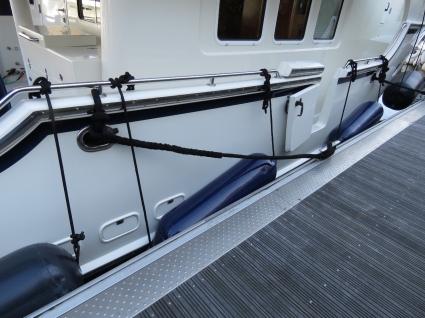
|
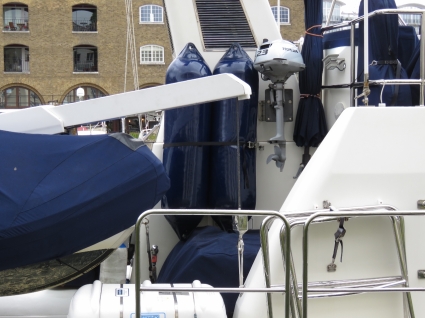
|
We like this approach, but still have the problem of inflatable quality. The two best-known solutions in market haven’t stood up well to our usage model. The Aere fenders cost $1,425/year over two years and we were constantly servicing them. The ProStock Marine fenders were better at $782/year over three years, but were still failing faster than we liked. Having tried the two best-known premium-priced inflatable fenders in market and had experienced early failures on both, we needed to find a better alternative.
It’s possible that one of the other premium-priced inflatable providers will eventually produce a product that wears well and/or has a warranty they will stand behind. It’s also possible that some of the very low-cost inflatable fenders on the market will produce a better price-performing solution. Since we have given the two highest load fendering jobs to Polyform, we feel more confident trying other inflatable solutions. Our plan is to try different solutions and go with the one that produces the least cost per year. Hopefully this will be less than the $782/year that ProStock Marine yielded in our application.
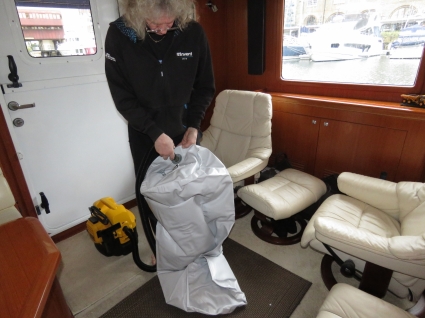
|
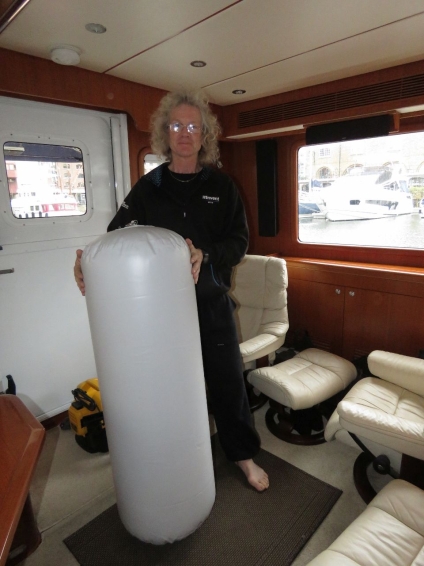
|
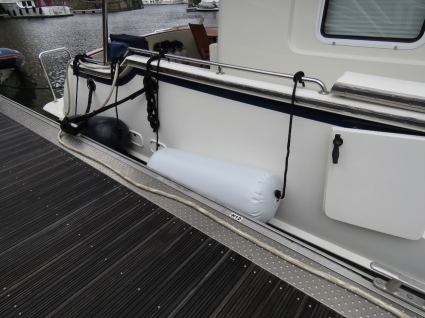
|
We tested the new EasyStore fender for a week or so and then concluded that it was worth buying three more and doing a multiple-year durability test. If they last two years, it’s an easy win for us. Since we have the Polyforms in the high-risk, high-load positions, we can more easily tolerate failures if they happen. And the EasyStores are so inexpensive it’s just about assured they will cost far less when amortized over their presumably shorter-than-premium-priced-fender lifetime.
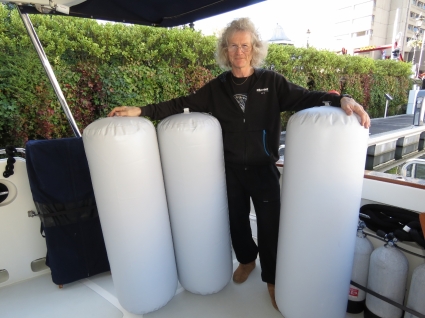
Basically, if you can’t get inflatables to last long well but you really like them, give the high load positions to another solution and go with non-premium-priced inflatable fenders for the remainder. Our thinking is we are going to be both better protected and the solution will cost us less per year than what we bought from either Aere or ProStock Marine. Ironically, this solution is so inexpensive that, if the EasyStore fenders last a bit more than a year, it would already be an economic win and we fully expect they will do better. We’ll know in a year and we’ll blog what we learn as time goes on.
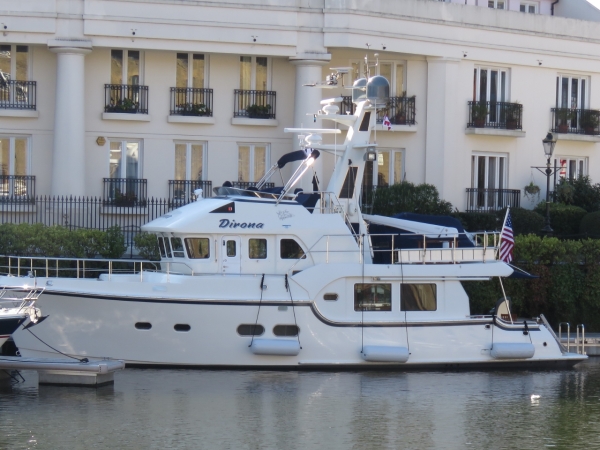
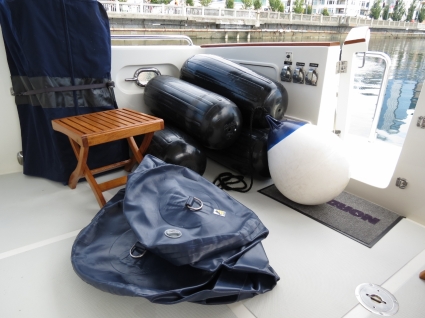
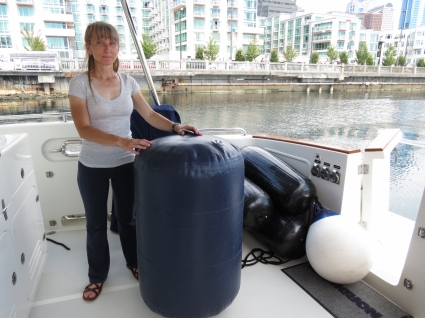
Was curious what inflatable you settled with. Also, when you found it appropriate to deploy the F8 horizontal. We’re diving into fenders right now and I really prefer the double eye end of the F series over the HTM, although I’m curious if you deploy the more typical seen HTM type in some occasions.
This is the final place where we ended up on fendering. We use Polyform F8 for the two central high load positions and we use low cost, no-brand inflatables everywhere else. We only use the two Polyforms (no HTM) and it seems like the non-brand name inflatables at 1/3 the cost last far longer than 1/3 of the life of Prostock Marine or Aeres. For the low cost inflatable fenders, we have different brands in test. The EasyStore feels light to the touch but in use it seemed to do remarkably well and we had no failures.
I like that plan. There is a 52 next to us and looking at the overall haul shapes and sizes I don’t think there is enough difference to warrant more F8 for critical loading than deployed on Dirona. I will start with (4) F8 and give the no-brands a try. I have (5) HTM’s on board which I will hang onto until they cease functioning.
Certainly 4 will work fine but the F8 are big and heavy. We went with only 2 F8 used only on the high load, on the dock side and used inflatables everywhere else.
James, Thanks for this feedback. We have been using our 4, originally supplied, inflatables in a very sheltered marina. Appreciate your feedback and feel your solution will work well for us. Will be purchasing two Polyform F8’s for the high load area. Appreciated, Peter
Inflatables do remarkably well under quite adverse conditions but, one night in southern UK, we saw 60 knots and had to ProStock Marine fenders fail. The Polyforms are just about indestructible. We think you’ll be happy with the combination you plan.
James, are the easy store fenders holding up well? Which model did you purchase? Our new-to-us N46 comes with a good supply of fenders’ but I need to lock out of the Great Lakes and I’m looking for a fender that will serve double duty as a fender board and portable emergency fender that can be run around the boat to fend off the unexpected. Would the F8s be too heavy?
We love the two F8s we’re using. They are the two central fenders that take the most load. We often use them as combination fenders/fender boards. They work very well for that application. Their downside is they are heavy at 16 lbs. We actually like the fact that they don’t get shifted by wind but they are heavy. We move them around the boat by dragging them behind us so they are easy to move but they wouldn’t be our choice if we wanted to quickly get a fender between our boat and another in an unfendered area. For that application, inflatables win and that’s why we still have a lot of inflatable fenders in use on Dirona. They have lots of upsides.
Thanks for the heads-up. I currently have 3 Polyform F7 fenders and a F10 for the bow. I was thinking of switching to inflatables to save space and I wasn’t sure how the Polyforms compared since I had one of the F7s burst at the Seattle locks which killed my confidence in them. In hindsight part of the problem was I failed to make sure the lock personnel tied our stern to the correct cleat. A cleat too far aft was chosen which left the boat subject to twisting with extreme pressures.
On a positive note, the fender was replaced under warranty w/o issue.
I love your blog!
Michael! It’s great hearing from you. Good to hear you are still boating and enjoying Seattle.
If you managed to burst an Polyform F7, I’m impressed. Good to hear that Polyform replaced it under warranty without debate. Polyforms are massively thicker, more durable, and able to take more abuse than the inflatables. However, the inflatables are smaller, lighter, easier to manage and much easier to store. Our current solution is to Polyform F8s for the two highest load fenders and then inflatables for the rest in an effort to get near indestructible for the high load fenders and easy to handle, store, and deploy for the rest.
Say hi to Tom.
We bought 6 ProStocks based on your blog post about them. We’ve been mostly happy with them, except in our most extreme condition: tied up in the Key West Bight Marina during Hurricane Irma! Four of them were between the boat and the dock. One of them was punctured by something sharp on a piling. One’s valve broke (blunt force trauma, I suspect. And the other two blew up and out of the gap.
I don’t fault ProStock for any of these. Irma was a big storm with 90 mph winds measured at our location. They repaired both of the failed ones for free (we took them in, as we remained in S Florida for some time after the storm. And the next time, we’ll put some water in them to keep them from blowing out of place.
Still, the idea of two PolyForm F8’s is appealing. If we can find a place to stow them.
Thanks for passing on your experience with Prostock Marine Brian. My take is loosing three fenders is a house-on-fire event. Our experience of having two inflatable fenders fail in a single night is why we decided to go with two Polyform F8 in the highest load positions. But, had we not already made that decision, your note would have done it for us. We’re glad we went with the Polyforms and like our stowage solution. They hybrid conventional and inflatable solution gives many of the advantages of inflatables with the durability of the Polyform fenders.
James and Jennifer : Is there a reason you have rejected using Scotsmen buoys (Polyform A-3 or A-4’s)? They are relatively light, very durable and can be collapsed between uses. They are the “fender of choice” for many commercial vessels.
Jim
When up against a wall, a Scotsmen performs very well and is a good choice. When up against pilings or uneven structures like a narrow dock with lots of room underneath it, a round fender can slip down and out of the way allowing dock contact and will slip to the side when up against pilings. Using longer fenders gives a less compact solution but it’s more general purpose in that it works well on pilings, thin docks without much surface to put a fender against, and solid walls where just strength is required. We have nothing against Scotsmen but don’t want to carry a large variety of different fenders so we tend towards the more general solutions.
You can’t go wrong with Polyform. Most Polyform fender have valves to inflate/deflate so they take a bit less space.
You are right, Polyform fenders do have valves so, technically are “inflatable” but the way we use them is always inflated. We don’t take them down to stow them.
PS Apparently, the hypalon fenders are considerably heavier than a PU / PVC fender due to the very heavy duty material they are made with which minimises the chance of them blowing out of position. Only downside is you need to be sitting down when looking at the prices!
Having done two cycles on expensive inflatables that failed to last, we’re now trying a different approach: 1) a pair of Polyform F8s for the high load positions, and 2) a set of inexpensive inflatables for the low load positions.
Hi James,
Did you look at Henshaw Inflatables? They mostly make tubes for ribs, but they also make heavy duty inflatable fenders up to enormous sizes. We have used them for a rib re-tubing and were very pleased. They have an excellent reputation (no connection to me). The fenders are made of Hypalon, so I would have thought you could repair them yourself if you needed. I have a similar set made by Avon inflatables, and they saved our bacon in a storm in South Africa……